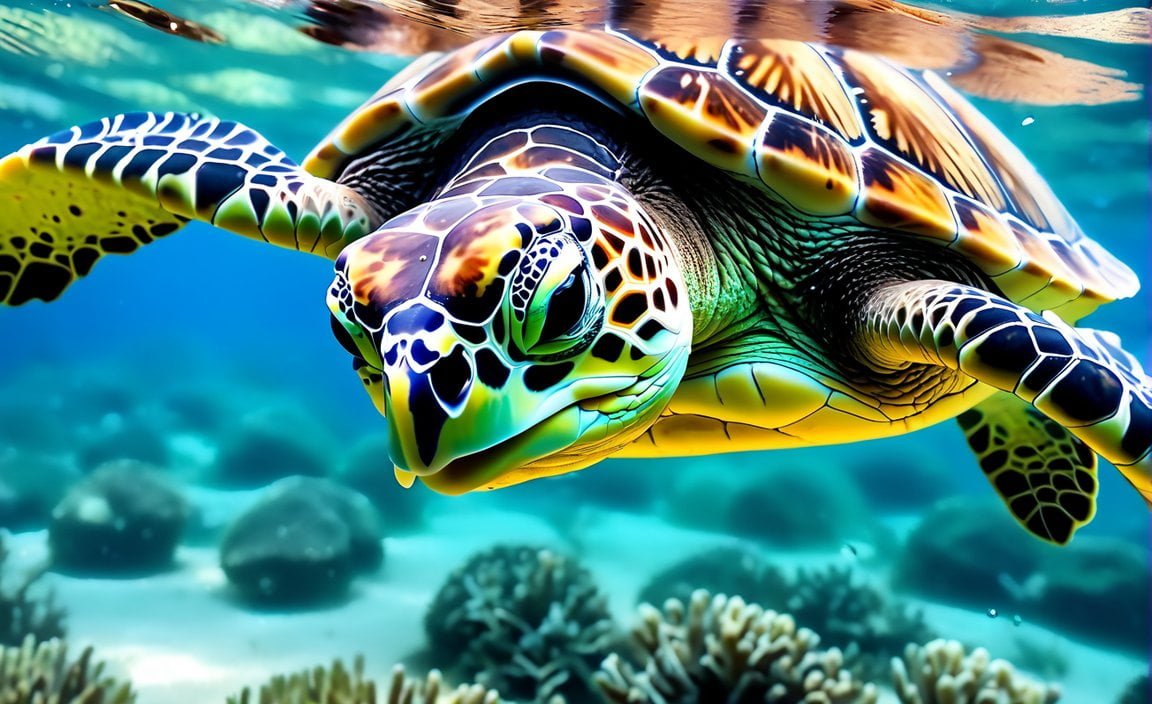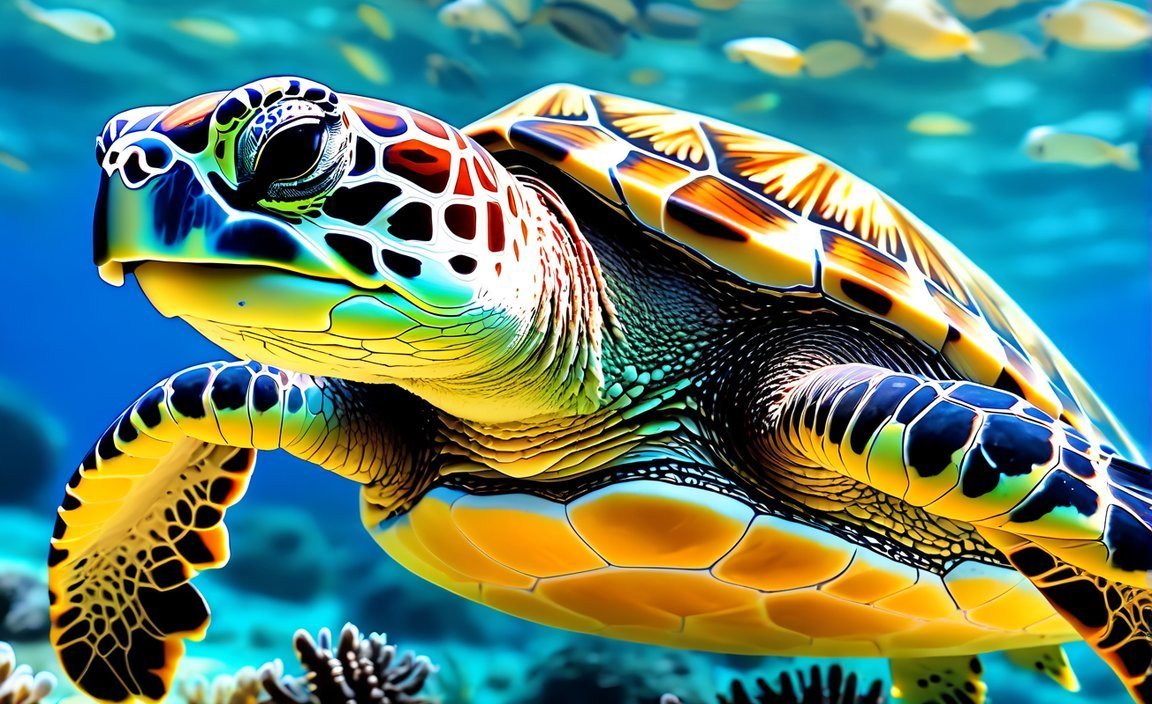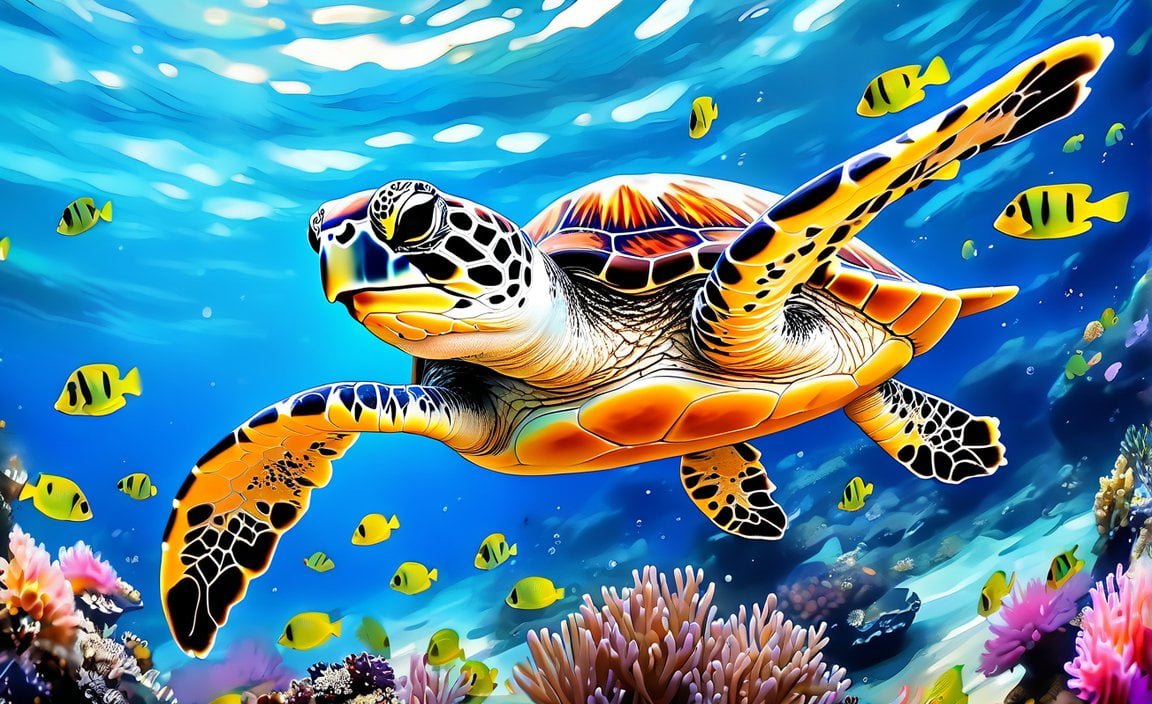Welcome to a world of wonder and beauty as we embark on a journey to discover 10 fascinating facts about hawksbill sea turtles. These incredible creatures are not only known as coral reef gardeners, but they also possess a special armor that protects them in their ocean home. Join us as we delve into their arduous journey to reproduce and uncover four other fun facts that will captivate your imagination and ignite a passion for the conservation of these enchanting beings.

Key Takeaways:
- Hawksbill sea turtles have distinct features like pointed beaks and vibrant colors, resembling hawks.
- The largest known colony of hawksbill sea turtles is located on Milman Island in Queensland, Australia.
- These turtles have been swimming in the oceans for longer than humans have existed on Earth.
- Hawksbill sea turtles have unique mouths and patterned shells.
- They contribute to healthy coral reefs by consuming sponges, a diet only they can sustain.
- Hawksbill sea turtles play a vital role in maintaining the functioning of marine ecosystems.
- Conservation efforts are crucial to preserving these fascinating creatures for future generations.
10 Fun Facts About Hawksbill Sea Turtles
As a passionate marine biologist with expertise in hawksbill sea turtles, I am excited to share 10 fun and captivating facts about these enchanting creatures. Get ready to dive into the fascinating world of hawksbill sea turtles and discover what makes them so unique and special.
Fact 1: Beautiful Looks and Unique Features
Hawksbill sea turtles are easily recognized for their strikingly beautiful colors and pointed beaks. Their long, narrow head and hawk-like beak give them a distinctive appearance, resembling hawks that soar through the skies.
Fact 2: Largest Colony in Queensland, Australia
Did you know that the largest colony of hawksbill sea turtles in the world can be found nesting on Milman Island in Queensland, Australia? This remarkable spot is teeming with these incredible creatures, providing a haven for their nesting activities.
Fact 3: Ancient Creatures of the Sea
Hawksbill sea turtles have been swimming in the oceans for much longer than humans have been on Earth. These intriguing creatures have a history that dates back millions of years, making them one of the oldest species on our planet.
Fact 4: Beak-Like Mouths and Patterned Shells
One of the unique features of hawksbill sea turtles is their beak-like mouths and intricately patterned shells. Their mouths are perfectly adapted for their diet, while their shells showcase a mesmerizing combination of colors and patterns.
Fact 5: Sponge-Eating Specialists
Hawksbill sea turtles play a vital role in maintaining the health of coral reefs. They have a special dietary preference for sponges and are the only species of sea turtles that can survive mainly on a sponge-based diet. By eating sponges, they help keep coral reefs clean and thriving.
Fact 6: Guardians of Marine Ecosystems
Hawksbill sea turtles serve as key players in the functioning of marine ecosystems. Their presence helps to maintain the delicate balance of underwater life as they feed on sponges, which can otherwise overgrow and threaten the survival of other species.
Fact 7: Urgent Need for Conservation
Conservation efforts are crucial to protect hawksbill sea turtles for future generations. These delightful creatures face numerous threats such as habitat destruction and illegal hunting. By raising awareness and supporting conservation initiatives, we can contribute to preserving their population and their vital role in the marine ecosystem.
For a more in-depth understanding of hawksbill sea turtles and their fascinating world, I recommend visiting the following sources:
Let’s continue to spread awareness and appreciation for these enchanting creatures, inspiring others to join in the efforts of conserving our beautiful oceans and the incredible hawksbill sea turtles that call them home.
Here are some captivating facts about hawksbill sea turtles that will leave you amazed. Did you know that hawksbill sea turtles play a crucial role in maintaining the health and balance of coral reefs? They love munching on sponges, which helps corals grow and thrive. Explore more fascinating facts about these incredible creatures here: 10 interesting facts about hawksbill sea turtles
#4 Special Armour
The Hawksbill Sea Turtle is truly a remarkable creature, and one of its most fascinating attributes is its special armor. These turtles have a unique shell that sets them apart from other sea turtle species and gives them the ability to navigate their challenging environment with ease. Let’s dive deeper into this incredible feature and explore why it makes the hawksbill sea turtle so special.
1. A Shell Like No Other
The shell of a hawksbill sea turtle is truly extraordinary. What makes it so remarkable is its composition. Unlike other turtles, the hawksbill’s shell is made up of overlapping scales called scutes, which form a hard and protective layer. These scutes are arranged in a distinctive pattern, resembling the tiles of a roof. It’s almost like having a suit of armor!
2. Lightweight and Flexible
Despite its formidable appearance, the hawksbill’s shell is surprisingly lightweight and flexible. This allows the turtle to move swiftly and gracefully through the water, maneuvering effortlessly among coral reefs and rocky crevices. Its special armor doesn’t weigh it down but instead provides the perfect balance of protection and agility.
3. Built for Coral Reefs
The hawksbill sea turtle’s shell serves a crucial purpose in its unique habitat – coral reefs. The intricate pattern of its shell allows it to blend in with the vibrant colors and textures of the coral, providing a natural camouflage. This camouflaged armor helps protect the hawksbill from potential predators and increases its chances of survival in the complex reef ecosystem.
4. Adapted for Feeding
The hawksbill’s special armor also aids in its feeding behavior. With its narrow, beak-like head and sharp, serrated jaws, it can effortlessly reach into narrow crevices and extract its preferred diet – sponges. The protective shell not only allows the hawksbill to access its food source but also shields it from potential harm in the process.
5. A Shield Against Predators
The hawksbill’s special armor acts as a shield, helping to deflect attacks from predators. The scutes on its shell provide a layer of protection against bites from sharks and other predators, reducing the risk of injury. It’s like having a built-in shield that keeps the hawksbill safe during its long journeys in the vast ocean.
Key Takeaways:
- The hawksbill sea turtle has a unique shell made up of overlapping scutes.
- This shell is lightweight and flexible, allowing for easy movement.
- The hawksbill’s shell serves as both camouflage and protection in coral reefs.
- Its distinctive beak-like head and sharp jaws are perfect for feeding on sponges.
- The shell acts as a shield against predators, reducing the risk of injury.
Sources:
– 25 Facts About Hawksbill Sea Turtles – Wildlife Informer
– Greentumble
The Hawksbill Sea Turtle’s Arduous Journey to Reproduce
Hawksbill sea turtles embark on a remarkable and challenging journey when it comes to reproduction. This arduous process involves multiple stages and can span several years. Let’s explore the fascinating details of the hawksbill sea turtle’s reproduction journey.
1. Migration to Nesting Sites
To begin the journey, female hawksbill sea turtles leave their foraging grounds and embark on a long and perilous migration towards the beaches where they were born. These nesting sites are often located on small, secluded beaches, making it a challenging task for the turtles to locate them.
2. Timing and Mating
Once the females arrive at the nesting sites, they meticulously choose the perfect moment to begin nesting. Hawksbill sea turtles are known for their irregular nesting habits, often returning to the same beach every three to seven years. This infrequency adds to the challenges they face in successfully reproducing.
During mating, the males actively pursue the females, engaging in courtship behavior to win their attention. This process typically occurs in the water, where the males use their claws to grasp and hold onto the females during mating.
3. The Nesting Ritual
After successful mating, the female a hawksbill turtle selects a suitable nesting spot on the beach, digging a deep hole using her hind flippers. This task requires immense physical effort, as she uses her body weight to excavate a nest cavity in the sand.
Once the nest cavity is prepared, the female begins to lay her eggs. Hawksbill turtles can lay around 140 eggs per nest, and some nests may even contain over 200 eggs. This process can be physically taxing for the females as they use their powerful back flippers to carefully position each egg within the nest.
4. Vulnerability
Once the eggs are laid, the female hawksbill sea turtle carefully covers the nest with sand, camouflaging it to protect it from predators and the elements. This period leaves the eggs vulnerable to various threats such as poaching and natural predators.
5. Incubation Period
The eggs are left to incubate in the warm sand, with the temperature playing a crucial role in determining the sex of the hatchlings. Warmer temperatures typically result in more females, while cooler temperatures lead to more males.
The incubation period can vary, ranging from 50 to 80 days depending on the environmental conditions. During this time, the eggs undergo a transformative process, developing into fully formed hatchlings within the safety of their sandy nest.
6. Hatchling Race to the Water
When it’s time for the hatchlings to emerge, they synchronize their hatching to ensure a collective dash towards the ocean. This phenomenon, known as the “emergence party,” aims to enhance their survival chances.
Once the hatchlings emerge from the nest, they instinctively make their way towards the sea, guided by the natural light reflected on the water. This journey is filled with obstacles and predators, posing a significant challenge to the young and vulnerable hatchlings.
7. Early Life Challenges
After reaching the ocean, the hatchlings embark on a perilous journey of their own. They face numerous threats including predators, ocean currents, pollution, and habitat degradation. Only a small percentage of hatchlings survive to reach adulthood, which highlights the critical importance of conservation efforts in safeguarding this endangered species.
Key Takeaways:
– Female hawksbill sea turtles undergo an arduous migration to nesting sites.
– Hawksbill turtles mate infrequently, with males engaging in courtship behavior.
– Females meticulously choose a nesting spot and excavate a nest cavity in the sand.
– The nesting process includes laying around 140 eggs per nest.
– The vulnerability of the eggs during the incubation period exposes them to various threats.
– The temperature during incubation determines the sex of the hatchlings.
– Hatchlings synchronize their emergence and face challenges as they make their way to the ocean.
– Only a small percentage of hatchlings survive to reach adulthood.
Sources:
– Wildlife Informer. (n.d.). 25 Facts About Hawksbill Sea Turtles. Retrieved from
– Greentumble. (2017, August 25). Fun Facts About the Hawksbill Sea Turtle. Retrieved from

FAQ
Q1: What is the role of hawksbill sea turtles in maintaining the health of coral reefs?
A1: Hawksbill sea turtles play a unique role in maintaining the health of coral reefs by preventing sponges from overgrowing corals and suffocating reefs. They feed almost exclusively on sponges, which helps to maintain the balance between sponges and corals.
Q2: How many times do hawksbill sea turtles nest in a season and how many eggs do they lay per nest?
A2: Hawksbill sea turtles nest nearly four times per season. Each nest contains approximately 140 eggs, although some nests may have over 200 eggs. These layings are spaced out at 2-week intervals, resulting in a maximum of 800 eggs laid in two months.
Q3: Why are hawksbill sea turtles considered to be endangered?
A3: Hawksbill sea turtles are considered to be endangered worldwide due to habitat reduction and illegal hunting. Within the United States, they are listed as endangered because of habitat reduction and adults being captured for illegal animal trading. They are also at risk of consuming plastic, mistaking it for jellyfish, which can be harmful to their health.
Q4: Are hawksbill sea turtles biofluorescent and what is the reason behind this characteristic?
A4: Yes, hawksbill sea turtles are biofluorescent, although the reason behind this characteristic is still unknown. Biofluorescence refers to the ability to emit light in a different color after absorbing light of a different color.
Q5: How frequently do hawksbill sea turtles mate and reproduce?
A5: Hawksbill sea turtles have an arduous journey to reproduce. They meet only every three to seven years to mate and reproduce. This infrequent mating behavior makes their reproductive cycle longer compared to other species of sea turtles.










